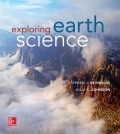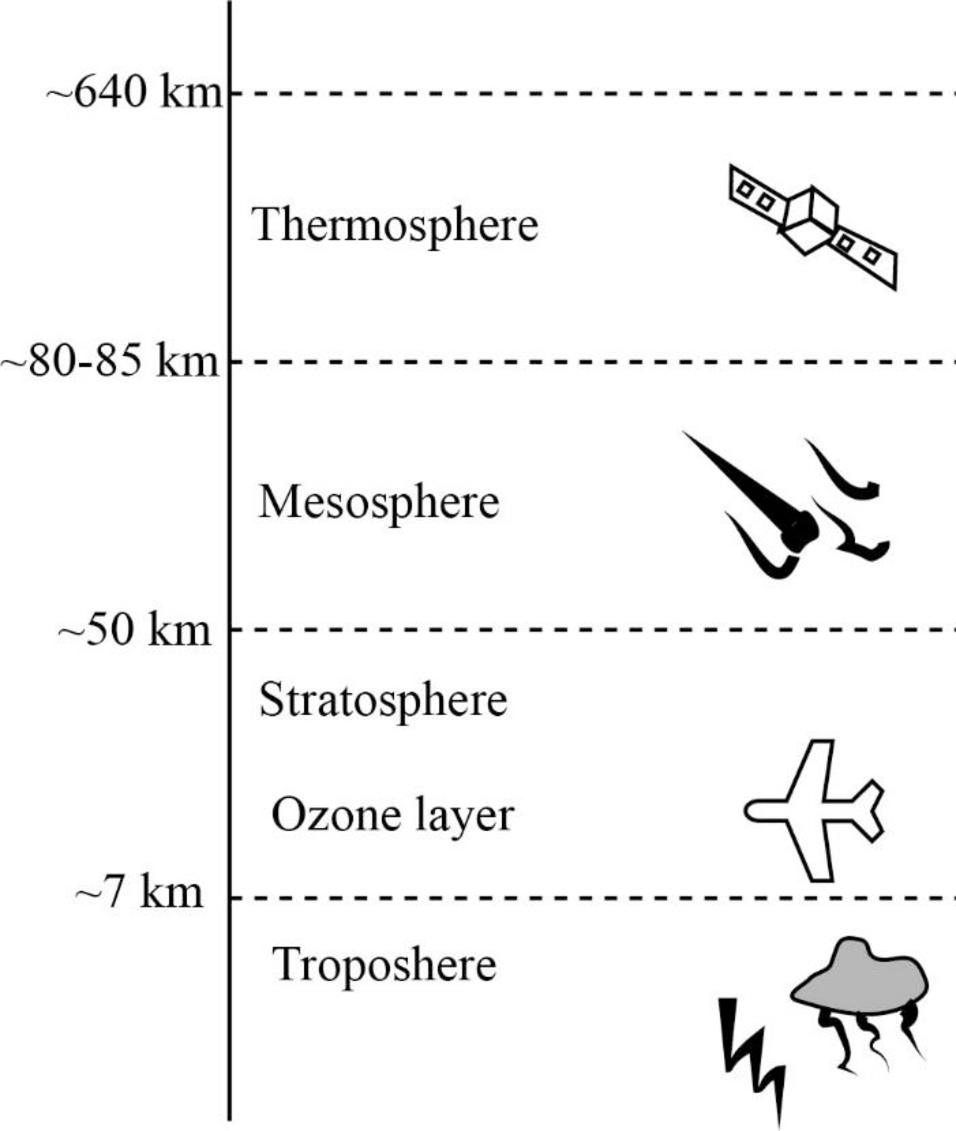
The description about the layers of the atmosphere using a sketch.
Answer to Problem 1BYL

The various layers of atmosphere from the bottom to the top of the Earth’s surface include troposphere, stratosphere, mesosphere, and thermosphere. The swirling motion of clouds, wind, and other manifestations of weather occurs in the troposphere. Commercial jets fly in the stratosphere, burning up of small meteorites take place in the mesosphere, and auroras are formed in the thermosphere.
Explanation of Solution
The atmosphere of the Earth stretches from its surface upward, for greater than 100 km. The atmosphere is not homogeneous in any of its attributes; however it is characterized by different layers that vary in temperature, air pressure, and the amount and composition of gases. The four different layers of the atmosphere are troposphere, stratosphere, mesosphere, and thermosphere.
The lowest layer of the atmosphere that extends from close to the Earth’s surface is the troposphere. The word “tropo” is derived from Greek, which means turning or mixing, on account of the swirling motion of clouds, wind, and other weather manifestations. It is the layer where the interaction of surface inhabitants occurs. It is characterized by the breathable air, clouds, wind, rain, and other weather aspects.
The layer of the atmosphere that exists above the troposphere is known as the stratosphere. It begins at an altitude of about 10 km above the sea level. The term is derived from Latin, which means spreading out, in reference to its layered or non-mixing character. In this layer, the temperature is also layered and it varies from cooler lower altitudes to warmer upper ones. Many commercial jets fly on the lowest part of the stratosphere due to the ability of air to offer less resistance to motion and thereby allow appreciable savings in fuel.
The layer that is situated above the stratosphere and in the middle of the atmosphere is known as the mesosphere. The word “meso” meant middle, in Greek. The mesosphere starts at an altitude of about 50 km at the top of the stratosphere and goes up more than 80 km in altitude. The upper part of the mesosphere is very cold, and it is considered as the coldest place that exists within the Earth system by many scientists. It is the layer at which the burning up of small meteorites take place, which consequently generates the effects known as shooting stars. The radio waves emitted from the Earth bounce off this layer and the overlying layer.
The topmost layer of the atmosphere is known as the thermosphere. The word is derived from the Greek word for heat. When gas particles intercept the energy of Sun, it becomes very hot and would be more than 1500 degree Celsius. In this layer, the interactions of solar energy and energetic gas molecules result in the formation of spectacular auroras.
Want to see more full solutions like this?
Chapter 13 Solutions
Exploring Earth Science
 Applications and Investigations in Earth Science ...Earth ScienceISBN:9780134746241Author:Edward J. Tarbuck, Frederick K. Lutgens, Dennis G. TasaPublisher:PEARSON
Applications and Investigations in Earth Science ...Earth ScienceISBN:9780134746241Author:Edward J. Tarbuck, Frederick K. Lutgens, Dennis G. TasaPublisher:PEARSON Exercises for Weather & Climate (9th Edition)Earth ScienceISBN:9780134041360Author:Greg CarbonePublisher:PEARSON
Exercises for Weather & Climate (9th Edition)Earth ScienceISBN:9780134041360Author:Greg CarbonePublisher:PEARSON Environmental ScienceEarth ScienceISBN:9781260153125Author:William P Cunningham Prof., Mary Ann Cunningham ProfessorPublisher:McGraw-Hill Education
Environmental ScienceEarth ScienceISBN:9781260153125Author:William P Cunningham Prof., Mary Ann Cunningham ProfessorPublisher:McGraw-Hill Education Earth Science (15th Edition)Earth ScienceISBN:9780134543536Author:Edward J. Tarbuck, Frederick K. Lutgens, Dennis G. TasaPublisher:PEARSON
Earth Science (15th Edition)Earth ScienceISBN:9780134543536Author:Edward J. Tarbuck, Frederick K. Lutgens, Dennis G. TasaPublisher:PEARSON Environmental Science (MindTap Course List)Earth ScienceISBN:9781337569613Author:G. Tyler Miller, Scott SpoolmanPublisher:Cengage Learning
Environmental Science (MindTap Course List)Earth ScienceISBN:9781337569613Author:G. Tyler Miller, Scott SpoolmanPublisher:Cengage Learning Physical GeologyEarth ScienceISBN:9781259916823Author:Plummer, Charles C., CARLSON, Diane H., Hammersley, LisaPublisher:Mcgraw-hill Education,
Physical GeologyEarth ScienceISBN:9781259916823Author:Plummer, Charles C., CARLSON, Diane H., Hammersley, LisaPublisher:Mcgraw-hill Education,





